Discover the fascinating principle behind chromatographic separation and how it revolutionizes various industries.
Understanding the Principle of Chromatography
The principle of chromatography is based on the differential partitioning of a sample between the stationary phase and the mobile phase. The stationary phase provides a surface on which the sample components can interact, while the mobile phase carries the sample through the stationary phase.
The separation is achieved through a combination of two processes: adsorption and partition. Adsorption occurs when the sample components adhere to the surface of the stationary phase, while partitioning occurs when the sample components distribute themselves between the stationary phase and the mobile phase.
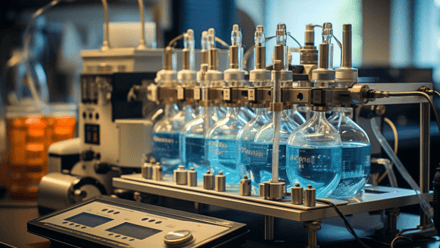
The relative affinities of the sample components for the stationary phase and the mobile phase determine their retention times and separation. Components that have a higher affinity for the stationary phase will be retained longer, while components that have a higher affinity for the mobile phase will elute faster.
By understanding the principles of chromatography, scientists can optimize the separation conditions and manipulate the selectivity and resolution of the technique to achieve the desired separation and analysis.
Applications of Chromatographic Separation
Chromatographic separation has a wide range of applications in various industries. Some of the key applications include:
1. Pharmaceutical Industry: Chromatography is used for drug discovery, quality control, and analysis of pharmaceutical compounds.
2. Environmental Analysis: Chromatography is used to analyze pollutants and contaminants in air, water, and soil samples.
3. Food and Beverage Industry: Chromatography is used for quality control, flavor analysis, and identification of food additives.
4. Forensic Science: Chromatography is used for drug testing, toxicology analysis, and identification of trace evidence.
5. Biotechnology: Chromatography is used for purification of proteins, nucleic acids, and other biomolecules in biopharmaceutical production.
The versatility and precision of chromatographic separation make it an essential tool in these industries and many more.
Use of Chromatographic Separation in Biopharmaceutical
Biopharmaceutical companies employ chromatography separation techniques extensively in their processes. Let’s delve into how they utilize these methods:
-
Characterization of Biopharmaceuticals:
- Liquid Chromatography (LC) coupled with mass spectrometry (MS) (LC-MS) is a powerful technique used during drug development. It helps characterize biopharmaceuticals by analyzing their structure, variants, and impurities.
- Ultraviolet-visible (UV-Vis) and photodiode array (PDA) detectors are commonly used for routine analysis of biopharmaceuticals1.
-
Specific Applications:
- Determining Drug-to-Antibody Ratios: LC techniques such as reversed-phase liquid chromatography (RPLC), hydrophobic interaction chromatography (HIC), and size-exclusion chromatography (SEC) are employed to determine the ratios of drugs to antibodies in therapeutic formulations.
- Evaluating Drug Load Distribution: Chromatography helps assess how drugs are distributed on antibody molecules.
- Analyzing Process-Related Impurities: LC methods are used to detect impurities in antibody-drug conjugates1.
-
Quality Control and Monitoring:
- Biopharmaceuticals are derived from living cells, leading to structural heterogeneity. Regular monitoring ensures the right compound formation and desired purity.
- Contaminants (e.g., host cell proteins) during manufacturing or storage require periodic analysis.
- Biosimilars, similar to innovator products, undergo testing for quality and efficacy1.
Modeling Chromatographic Separation using Ansys Fluent
Chromatographic separation is a rapidly evolving field, and researchers are constantly developing new techniques and improving existing methods. Simulation and modeling play a crucial role in the design of liquid chromatographic separation. By utilizing advanced software like Ansys Fluent, scientists and researchers can simulate and optimize the separation conditions to achieve the desired results. Through simulation, they can manipulate various parameters such as column dimensions, flow rates, and stationary phase properties to enhance the selectivity and resolution of the separation. This allows for a more efficient and cost-effective design process, as it reduces the need for trial-and-error experimentation. Additionally, simulation and modeling enable researchers to gain a deeper understanding of the underlying principles of chromatography and explore innovative approaches to improve separation techniques. It is through these advancements in simulation and modeling that the field of chromatographic separation continues to evolve and revolutionize various industries, from pharmaceuticals to biotechnology.
In this case we demonstrate the use of simulation for modeling fluid flow and species separation inside a biopharmaceutical chromatography column. The chromatography column has four inlets and four outlets. The packed column is defined as a porous zone where the column packing porosity and permeability influence the pressure and flow distribution of the tracer that is injected into the column.
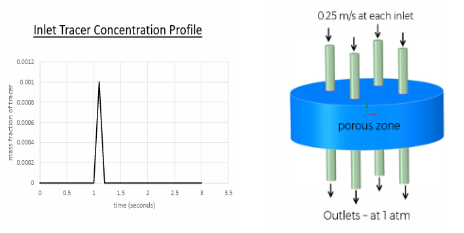
Figure 1: Chromatography Column and the Inlet Tracer Concentration Profile
Figure 2 shows the tracer injection advancement through the column at different time intervals along x=0 and z=0 cross-sectional plane.
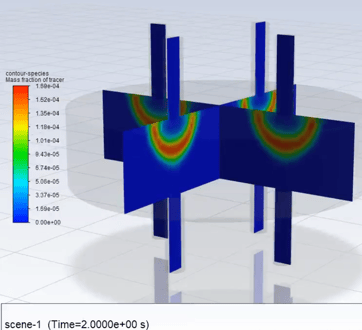
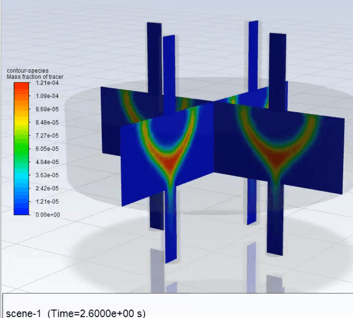
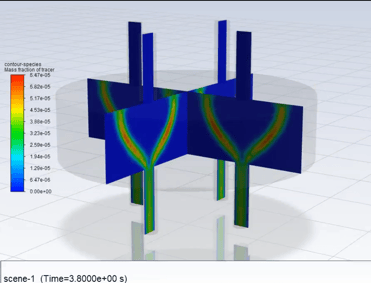

Figure 2: Tracer Concentration Profile as a Function of Time
In conclusion, chromatographic separation is a powerful technique that revolutionizes various industries, from pharmaceuticals to biotechnology. By understanding the principles behind chromatography and utilizing advanced simulation and modeling tools like Ansys Fluent, researchers can optimize separation conditions and enhance selectivity and resolution. The applications of chromatographic separation are vast, ranging from drug discovery to environmental analysis, showcasing its versatility and precision. As modeling continues to play a crucial role in the design and improvement of chromatographic techniques, it is exciting to see how this field will evolve and further impact industries in the future. For those interested in exploring the fascinating world of chromatography, delving deeper into the principles and applications can provide valuable insights and opportunities for further engagement in this dynamic field. Here is a short video describing how to set up this model using ANSYS Fluent.
Mar 15, 2024 4:52:53 PM
